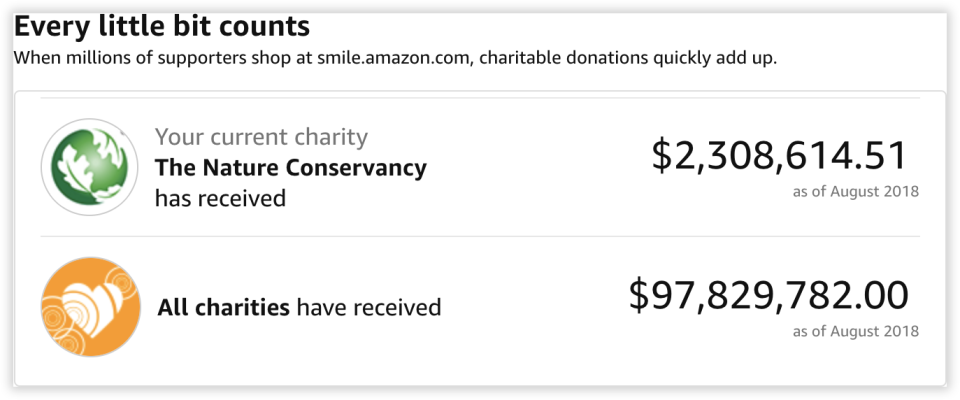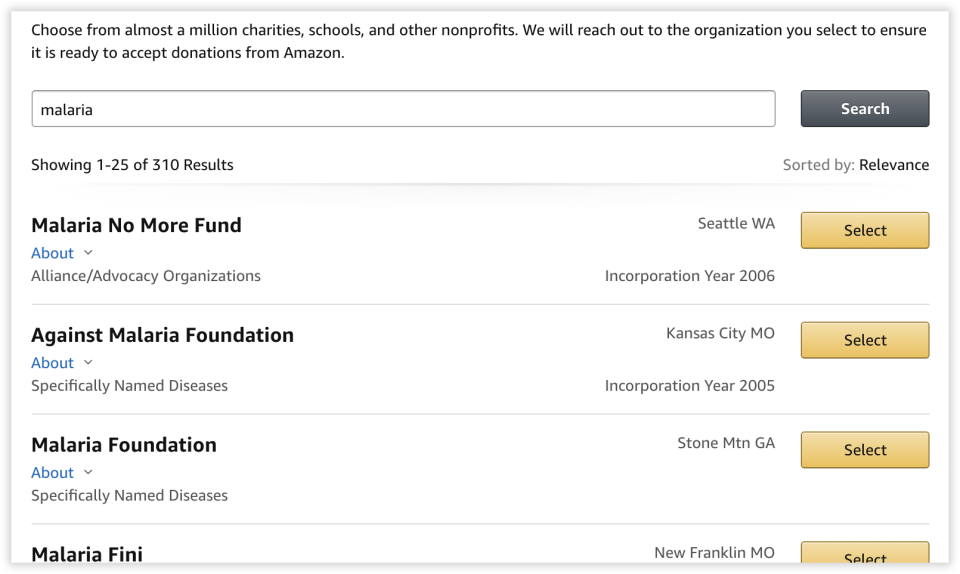Meet AmazonSmile, the company's charitable shadow clone site
Some people don’t know about Amazon’s shadow clone site, even though it launched five years ago.
It’s a complete, nearly perfect duplicate of Amazon.com. It sells the same things, for the same prices, with the same descriptions and customer reviews. Your shopping cart, Wish List, and other account settings are also the same.
The only difference: a piece of every purchase price goes to a charity that you’ve chosen.

It’s called AmazonSmile. The percentage Amazon donates is only half of one percent—but multiplied by the billions of dollars people spend on Amazon, it adds up. So far, AmazonSmile has paid out over $100 million to charities. (That’s up from $89 million when the interview above was recorded.)

How it works
The first time you go to smile.amazon.com, you choose from a searchable list of about 1 million charities. You can choose a different one at any time.

After that, you just shop as you ordinarily would. Every time you buy something, Amazon donates .5 percent to your chosen charity.
“Of course we have the St. Jude’s, and the ASPCAs, and the American Cancer Society as well, and all the big guys, and through to all the small guys. And every one of them has a different story to tell,” says AmazonSmile vice president Piers Heaton-Armstrong.
He notes, for example, that AmazonSmile donations have funded over 120 clean-water projects in developing nations through Charity: Water.
Then there’s Dancing Dreams, a charity in New York. “They help physically challenged kids get up on the stage, do a performance, and all of it’s completely free,” he says. “Through the Smile program, they’ve been able to give those kids ballet shoes.”
Some charities now rely on AmazonSmile as a fundraising channel by encouraging their fans to discover it. Tampa’s Big Cat Rescue Sanctuary, for example, has over 280,000 Twitter followers and 730,000 YouTube subscribers. The charity promotes its AmazonSmile link on its website and through its social-media channels.

It seems a little hard to believe. Why would Amazon, a profit-seeking entity, deliberately give away $97 million? There’s some PR value, of course, although Amazon doesn’t do much to promote it.
The arguments against Amazon Smile
Not everyone is a fan of Smile. Here and there, you can find online posts finding fault with it. For example:
Amazon could make it easier to use Smile. Amazon, according to this argument, is hoping that people will forget to go the duplicate site (smile.amazon.com). Why not let us use the regular Amazon site, but have a setting in our account that automatically directs our purchase payments toward the charities? And why isn’t there an app for Smile?
Participating in Smile may make you less likely to make more substantial donations. This argument says that, now that you feel good about yourself by shopping from Smile, you’ll be less likely to make your own donations to charities at year’s end.
Of course, the counterargument to the first point might go like this: If Amazon really wanted to minimize the amount it gives to charity, it shouldn’t have created Smile at all. It should not pop up reminders when you go to the regular Amazon instead of the Smile site by accident. And it should not be participating in interviews designed to spread the word.
And to the second point: “That’s the first I’ve heard of that one,” says Heaton-Armstrong. “I certainly hope that our customers that use the Smile program are also using other channels to support the charities of their choice.”
Is the whole thing a PR stunt to make Amazon look good? Maybe, but who cares? Plenty of huge corporations support charities. If image-building helps encourage them to be good corporate citizens, then so be it.
This much is for sure: If everyone used Smile instead of the regular Amazon site, the world’s charities would benefit hugely—at a tiny cost to Amazon and no cost to you. That’s as close to a win-win-win as you can find in the world of online commerce.
David Pogue, tech columnist for Yahoo Finance, welcomes comments below. On the Web, he’s davidpogue.com. On Twitter, he’s @pogue. On email, he’s poguester@yahoo.com. You can sign up to get his stuff by email, here.
More by David Pogue:


